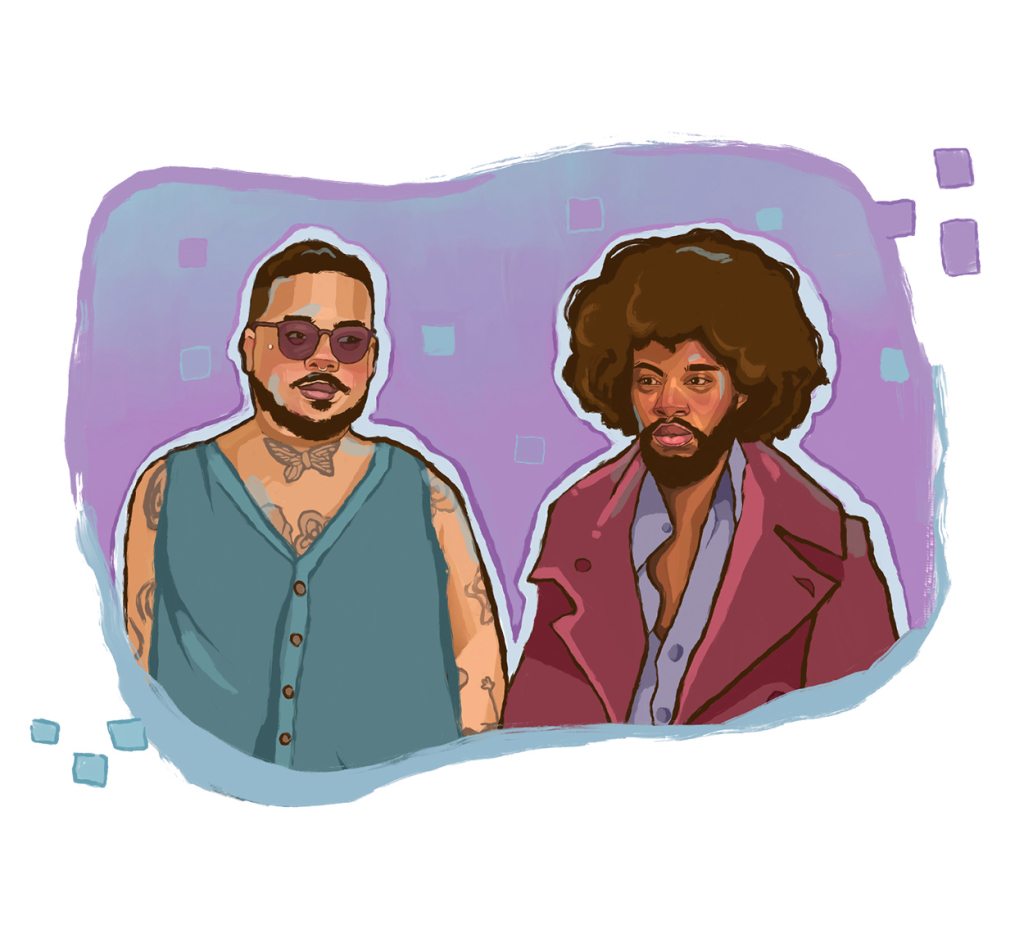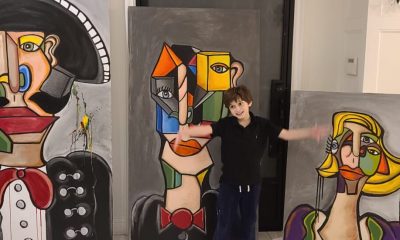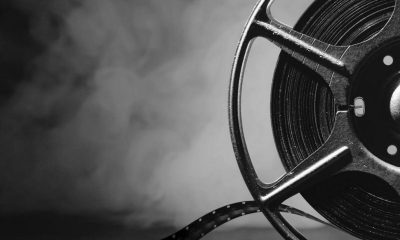ART WORLD NEWS
Jeremy O. Harris and Jonathan Lyndon on Queerness, Anime, and History – ARTnews.com
Jonathan Lyndon Chase: Artist in gowns, 2020, charcoal, marker, pen, watercolor, and glitter on paper, 14 by 11 inches.
Courtesy Company, New York.
The New York–based playwright and actor Jeremy O. Harris and the Philadelphia-based painter Jonathan Lyndon Chase are two Black queer artists who resolutely display their imaginations without restraint. On Harris’s stages and Chase’s canvases, the complexity of pleasure and the degradation of trauma are often explored through romantic fabulations that endeavor to move their subjects into the subconscious and beyond shame: both are drawn to the aesthetics of violation, and to recasting discomposure as empowerment. Harris, who owns a couple of Chase’s paintings, is best known for his 2018 Slave Play. The Broadway production, nominated this past October for a record-setting twelve Tony awards, is the story of three interracial couples who undergo “Antebellum Sexual Performance Therapy” in a search for self-love and shameless freedom. Chase’s colorful, expressive portraits of queer Black men—composites of friends, guys they dreamed up, or guys they saw on the street, internet, or train—depict mundane and explicit sex acts in drawing, painting, and collage. The two convened on Zoom in March to discuss their representational strategies, shared interests, and self-care routines. —Eds.
Related Articles
JEREMY O. HARRIS: I’m hanging your piece Artist in Gowns (2020) in my office, because it captures how I think of myself right now.
JONATHAN LYNDON CHASE: Oh, that’s such an honor. And thank you so much for going to see my show [at the Fabric Workshop]!
HARRIS: That was the best day of quarantine! The journey beyond my three-block radius seemed a little daunting, but I’m glad I did it—there was something so magical about being in a museum again.The person at the desk told me, “Jonathan made the best show I’ve ever seen.” It made me wonder if you think about the effect of your work—which is so often about pleasure, melancholy, and Black interiority—on docents and security guards, who are often Black.
CHASE: It’s disconcerting when museums are full of people of color, but not artists ofcolor. Visiting the Philadelphia Museum of Art, where many people of color work in security and janitorial positions, got me thinking . . . This amazing museum is Black and gay as fuck! I spend a lot of time casually talking to the people who work there, and they’re usually excited to talk, since most people walk right past them. They’re the ones who spend all day with the work!
HARRIS: I found that the people who could talk about Slave Play the best were the ushers, especially these four Black security women who were in the back night after night. They couldn’t always look at the stage because they were working, so they had this aural relationship to the play. That made me really excited about the idea that my play might work as a text, or as a radio play. And it made me realize that Slave Play can be seen by everyone—it’s not a play for an audience that knows enough about theater to “get it.” In fact, people who’ve been in theater for years and years had these convoluted takes on my play that made me wonder, what play did you even see? The people who had no formal training were the ones with the most astute, articulate takes. It made me wonder, what if our critics were the docents or the ushers who sit and live with the work day in and day out?
Jeremy O. Harris: Slave Play, 2018.
Photo Matthew Murphy
CHASE: I know that you adjusted the prices to make the play affordable to the people it’s actually talking about . . . The word that comes to mind is “accessibility.”
HARRIS: I often feel really alienated from queer work that’s considered canonical or, even worse, “on the rise.” That’s because of racism, but also because the loneliness and darkness that comes with queerness is so often glossed over. I appreciate that your work brings these more abject or fraught aspects to the fore: not in an aggressive, dark, Francis Bacon kind of way, but in a more mundane sense. Your work captures the loneliness you might experience during an orgy, or the feeling of listening to a mixtape while waiting for a guy to come over. Often, I find that my experience with mental health isn’t represented in queer work, or Black work, because people want to celebrate and are concerned about representation. I understand that, but I don’t need art to create fantasies for meall the time.
CHASE: That resonates with me. As someone living with bipolar disorder, it’s really important for me to talk about that full complex range. But when I’m representing violence, whether in the psyche or the physical body, I don’t use blood, for example. Whether in lynching postcards or on Instagram, there are too many images of our bodies just being paraded around. I’m trying to refute these one-dimensional ways we deal with the repercussions of, say, colonization or the gender binary.
HARRIS: One hundred percent. Rejecting blood as necessary for expressing our pain was a big thing for me when I was working on Slave Play. I grew up in the South, next to plantations, and I wanted to wrestle with that history in my work. But I didn’t want to just represent the fact. I’m much more interested in how it might live in our bodies and our imaginations. I was thinking more about that very blunt slave joke your grandma or uncle might tell at the dinner table. Maybe it’s provoked by how some lady looked at them at the grocery store, in a way that makes you realize: we haven’t moved past that point in our psyches, even if we don’t live with the blood and the sweat and the crack of the whip every day.
CHASE: I’m curious. Where does Jeremy end and begin, and when you are acting? How much vulnerability and autobiography is there in your work?
HARRIS: Processing the critical discourse around Slave Play, I was frustrated with some people’s inability to hold two things as truthful at the same time. I can write characters that are both myself and someone else. With Daddy [2019] or Slave Play, it was very easy for people to say, “Jeremy O. Harris is using theater to process his own relationship to interracial relationships.” In a way I was doing that, but why does the character Kenisha or Franklin have to be me? These figures represent fragments of myself that I’m using to explore bigger ideas about what whiteness and power might mean to my subconscious. I see the white figures in my work as representatives of the power structures that I navigate daily. White male patriarchy has been supportive of me in a litany of ways, like when I attended Yale. How do I process the fact that this place has fed me and housed me, but also made me feel alienated from my own history and from my community?
Jeremy O. Harris: Daddy, 2019.
Photo Sarah Krulwich
CHASE: I admire that your work is supposed to make people uncomfortable.
HARRIS: I think your work does the same! I bought two pieces by you, and I wanted to send one to my mom and keep one for myself. My mom lives with my nieces and nephew, and I found myself nervous about sending her the piece I wanted to send her: your Cleansing Rub (2020), which has this anus and obviously expresses a moment of Black queer ecstasy. In my work, I’ve been trying to actively run toward my own repressions and my own traumas that come from being socialized in a community that did not affirm seeking pleasure—at least not in the ways in which my body and my psyche wanted it. My work is about confronting the shame associated with pleasure—so I knew I had to give Cleansing Rub to my mom. I wanted my nephew and my nieces to grow up with that. . . .
How has your family responded to that inyour work?
Jonathan Lyndon Chase: Cleansing Rub, 2020, watercolor, pen, and marker on paper, 14 by 11 inches.
Courtesy Company, New York.
CHASE: My mom is my greatest artistic influence. She draws all the time, and I tried to emulate her as a kid. She was always really supportive of the fact that her kid wanted to do this crazy thing called art. Also, I came out when I was sixteen, and she was great about opening her mind.
HARRIS: I love that. I noticed there was a moment in the mid-’90s where my mom started to explore gender expression in a new way—I think a lot of Black women did, certainly a lot of my friends’ moms. They were wearing baggy pants and had a vaguely stud aesthetic. I think my work is indebted to my mom’s latent queer expression. Has your work licensed you and your mother to talk about these sorts of things, as two adults?
CHASE: In some ways. I was raised Baptist, and I guess I would call my mom “modest.” But she talks to me about the sexy crime thrillers that she reads.
HARRIS: I’m always so curious about how artists who were assigned male at birth relate to their mothers.
CHASE: Black women have really done the most, and continue to do the most,for us.
HARRIS: I’m happy to see that “Dragon Ball Z” poster behind you! I had a feeling that we both love anime, since I find that many Black nerds do. What was your entry point into anime?
CHASE: I was going to ask you about anime! My introduction to anime was “Speed Racer,” when it was still airing in black-and-white. I was really drawn to several characters’ level of maturity, and to the weird things the show did with gender—the animation style has a kind of feminine quality. I learned to draw figures through anime and manga, but I relate to both more as a queer person than as a Black person. Only in the last five years did we start seeing Black anime characters. When I got older, I learned how much “Sailor Moon” was censored on American networks, because the characters started crossing genders.
HARRIS: I’m with you. My first was probably “Sailor Moon” or “Cardcaptor Sakura,” since those came on Fox before school. This white lady cosplayer who lived next door would invite me to her house to watch the uncensored Japanese episodes of “Sailor Moon.” So when I was nine, I saw [the character] Sailor Uranus and all the lesbian stuff, the transitioning. The queerness attracted me to their world, but as I’ve gotten older, I’ve learned that a lot of their storytelling really influenced me. In “Naruto,” Rock Lee trains in taijutsu, and he decides that, if he wasn’t born a genius, he will make himself a genius with effort. I relate to that, because I didn’t feel like I had the same level of competency as people who were exposed to theater growing up. That story, of having to work twice as hard, is where I saw Blackness, in a way. I wonder where you see your work falling into art history, or do you have an interest in that? When your work inevitably becomes a part of longer historical conversations, how do you want it to be positioned or understood?
CHASE: I often get asked about the proximity to whiteness in my work, but for me, whiteness doesn’t have a place in it. My target audience is Black, queer, and gender nonconforming people, though it’s not that I don’t want white people looking at it. Kehinde Wiley, Mickalene Thomas, and Henry Taylor are painters I adore: I think the work we’re doing is making art spaces more accessible, not just not for the sake of representation but in order to have art seen by all kinds of people. Tell me what you do to take care of Jeremy. What is your self-care like?
HARRIS: During quarantine, I’ve rediscovered the gift of being swept away into a long, soap-operatic anime journey, or a great novel. In grad school I wasn’t reading or watching as much because I was focused on my own writing, but eventually, my well dried up. I get nutrients from the seven hours of anime I watched that one Saturday, or seeing a movie and having long conversations with friends about it afterward. I’m trying to build more time for that. I also started a flower budget: every week I get two bouquets for myself. How about you?
CHASE: I also love flowers, and I get them weekly, more or less. I’ve been getting into African spirituality, which has been super affirming. And I do boxing.
HARRIS: You do?
CHASE: Yes, even though I’m five-foot-seven and chubby! I also love poetry,and sex.
HARRIS: What’s your sign?
CHASE: I’m a Scorpio.
HARRIS: Of course you love sex. I’m a Gemini, so I like the pursuit of sex.
This article appears in the May/June 2021 issue, pp. 48–52.











